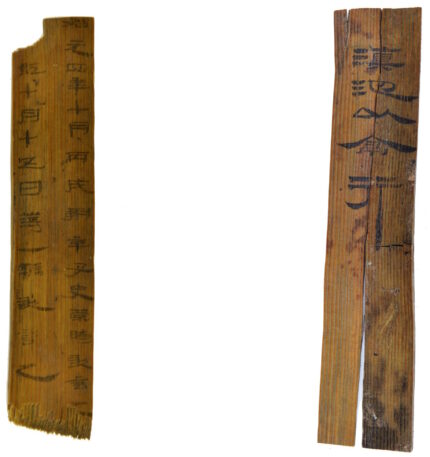Thousands of bamboo slips (rectangles tied together to form books) discovered at the Hebosuo archaeological site in southwestern China’s Yunnan province will help shed new light on the government of the Western Han Dynasty (202 B.C.- 25 A.D.) in Yunnan.
 More than 10,000 bamboo slips have been unearthed at the Hebosuo site since excavations began in 2021. Of those, about 2,000 date to the Han Dynasty (202 B.C.- 220 A.D.), 1,300 with written characters, 837 with seal impressions. Bamboo slips found in Western Han tombs are often literature and books about medicine and agriculture, but in this find the preponderance of the writing is administrative.
More than 10,000 bamboo slips have been unearthed at the Hebosuo site since excavations began in 2021. Of those, about 2,000 date to the Han Dynasty (202 B.C.- 220 A.D.), 1,300 with written characters, 837 with seal impressions. Bamboo slips found in Western Han tombs are often literature and books about medicine and agriculture, but in this find the preponderance of the writing is administrative.
Of particular note are the seal impressions because there are official seals from 20 of the 24 counties under the rule of the ancient Dian kingdom, a non-Han culture of agriculture-based settlements and exceptionally sophisticated metal workers centered in modern-day Yunnan. The kingdom was annexed by Emperor Wu of Han in 109 B.C.
Some of the slips record the names of 12 counties, such as “Dian Chi county” and “Jian Ling county,” which once belonged to the Yizhou Prefecture, an ancient region that was founded by Emperor Wu of the Han Dynasty after being defeated and started incorporation of the Dian Kingdom, a regime founded by an ancient ethnic group that lived along what is now the southwest frontier of Yunnan Province.
Other characters such as “county magistrate,” and “Dian Cheng” (prime minister of Dian management) were also discovered on the slips, Tao Zhongjun, a Chinese historian, told the Global Times on Tuesday, noting that such information shows a “well designed” social administrative system was used to govern the southwest border area.
Titles such as “Dian Cheng” reveal special political roles were set up by the Han government in the southwest area, said Jiang Zhilong, lead archaeologist on the Hebosuo project.
“Such discoveries are evidence that shows China was a unified country made up of multi-ethnic cultures,” Jiang noted.
Innocuous or ominous?—“Such discoveries are evidence that shows China was a unified country made up of multi-ethnic cultures.”
I suppose so, but (1) was the unity by agreement or by conquest, and (2) does the sentiment serve the current regime of mainland China in justifying its robust program of expansion and imposition of CCP Think?
Most Eurasian nations were formed by conquest. And the sentiment should be judged on its truth in this case. Naturally the Chinese authoritarian government seeks to use historical discoveries to push its agendas – as does the US corporate dominated democracy and as did the British Empire. What’s interesting is this is seldom reflected on in the English language reactions to historical discoveries in the English speaking nations or their allies.
This is my first time pay a quick visit at here and i am really happy to read everthing at one place